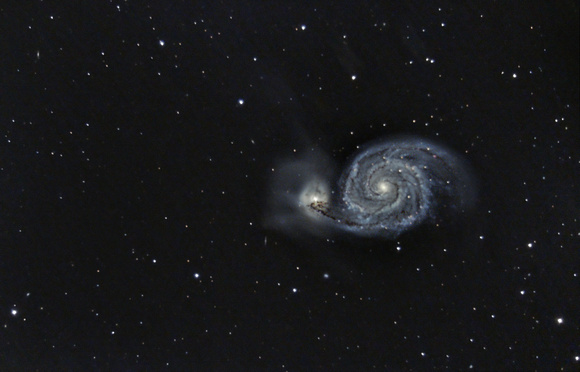M51 Galaxy
30 x 360Sec ISO 1600
Darks and Flats Applied
Scope: Celestron 1100 On CGE Mount
Guiding with PhD Meade 80mm ED
HUTECH MODIFIED CANON XTi
(Canon Rebel XTi (400DH) spectrum enhanced camera with built-in astronomical UV/IR blocking filter (Type Ib
Calibrated,Stacked and DDP by ImagePlus. Final processing with PS CS3
M51 is Located within the constellation Cans Venatici
It was not until 1845 that the Whirlpool became the first galaxy to be recognized as a spiral
The very pronounced spiral structure of the Whirlpool Galaxy is believed to be the result of the close interaction between it and its companion galaxy NGC 5195.
The famous Whirlpool galaxy Messier 51 (M51, NGC 5194) is one of the most conspicuous, and probably the most wellknown spiral galaxy in the sky.
M51 was one of Charles Messier's original discoveries: He discovered it on October 13, 1773, when observing a comet, and described it as a "very faint nebula, without stars" which is difficult to see. Its companion, NGC 5195, was discovered on March 21, 1781 by his friend Pierre Méchain, so that it is mentioned in Messier's 1781 catalog: `It is double, each has a bright center, which are separated 4'35". The two "atmospheres" touch each other, the one is even fainter than the other.' In addition to the description, in his personal copy of the catalog, Messier has added a small drawing, or sketch of the two "nebulae," M51 and NGC 5195, one of the rare cases a detailed drawing by Charles Messier of one of his objects is preserved. NGC 5195 was assigned an own catalog number by William Herschel: H I.186.
Occasionally, there is some confusion what is meant with the designation M51: The pair (justified by Messier's mention of both "nebulae") or the larger galaxy, NGC 5194. If the pair is meant, NGC 5194 is sometimes called "M51A", and NGC 5195 is then "M51B


